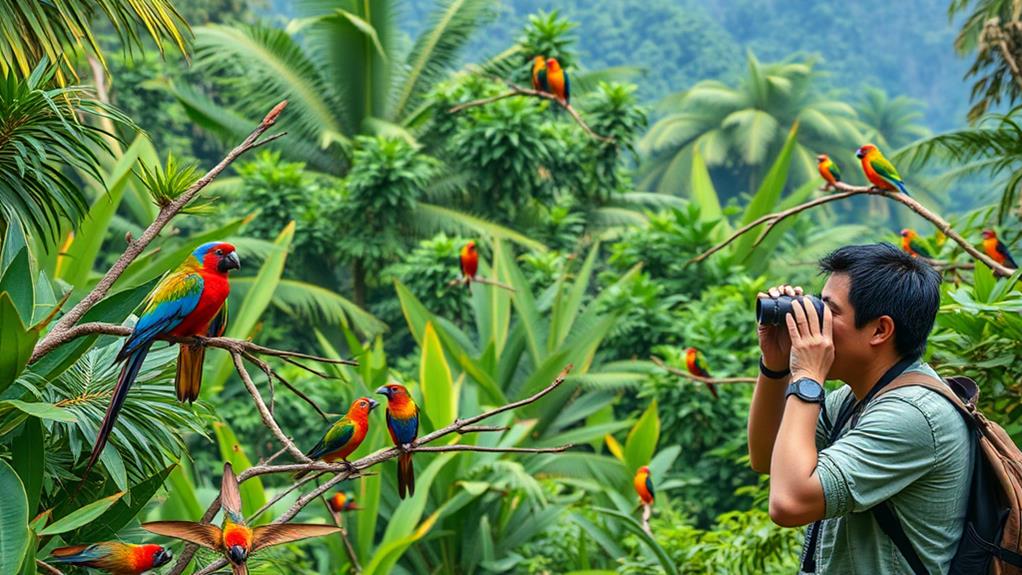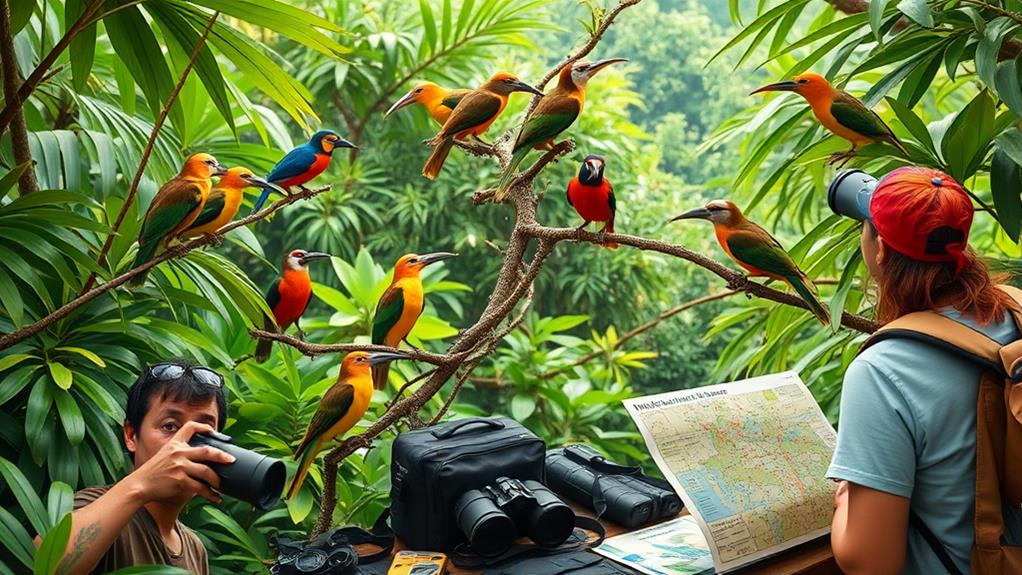The Philippines is a premier birdwatching destination, boasting around 600 species. This remarkable diversity is due to the country's 50 million years of geographic isolation, which has allowed species to evolve independently.
The varied habitats, ranging from rainforests to coastal wetlands, further contribute to the high level of endemism, with 172 species found only in the Philippines.
The best time for birdwatching is between November and April, when visibility is optimal. During this period, bird enthusiasts can spot critically endangered species like the Philippine Eagle.
Subic Bay and Mount Apo are prime hotspots, offering a rich avian diversity. To maximize the birdwatching experience, hiring local guides is recommended, as they can provide valuable insights into the region's unique avifauna and enhance sightings.
Overview of Philippine Bird Diversity

The Philippines is home to approximately 600 bird species, with 172 endemic species that can be found nowhere else in the world. This remarkable diversity is a result of the country's isolation for over 50 million years, which has led to high levels of endemism.
The Philippine Eagle and the Philippine Cockatoo are two critically endangered species that require targeted conservation efforts. These iconic birds, along with nearly 250 others, are found only in the Philippines and rely on the country's unique habitats, including lush rainforests and coastal wetlands, to survive.
Timing is crucial for spotting birds, especially during mating periods when certain species become more active. Birdwatchers can enhance their experience by visiting during these periods, when species are more visible and active.
For example, the Philippine Cockatoo is more easily spotted during its breeding season, which typically occurs from March to August.
The Philippines' diverse environments support a rich avifauna, making it a hotspot for birdwatching enthusiasts. As you explore the country's varied ecosystems, you'll discover a world teeming with unique avian life, each species playing a vital role in the ecological balance.
Conservation efforts are essential to protect these species and their habitats, ensuring the long-term health of the Philippines' ecosystems.
Importance of Endemic Species
The Philippines is home to a remarkable 237 bird species that can be found nowhere else in the world, making it a hub of unique biodiversity. This high level of avian endemism is a result of the archipelago's geographic isolation and diverse habitats.
Two critically endangered bird species, the Philippine Eagle and the Philippine Cockatoo, are prime examples of the country's unique avifauna. Unfortunately, they face severe threats, including habitat loss and illegal trade.
Threats to Endemic Birds in the Philippines
| Endemic Bird | Conservation Status | Key Threats |
|---|---|---|
| Philippine Eagle | Critically Endangered | Habitat loss, poaching |
| Philippine Cockatoo | Critically Endangered | Illegal trapping |
| Philippine Hawk-Owl | Vulnerable | Habitat degradation |
| Mindanao Bleeding-heart | Near Threatened | Habitat loss |
Conservation efforts are crucial to preserve these rare species, many of which are on the brink of extinction. Recent taxonomic changes have even increased the recognized endemic species, highlighting the need for ongoing research and protective measures. Understanding the importance of these endemic birds underscores the richness of the Philippines' avian life and the urgency of conservation initiatives.
Best Birdwatching Seasons

November to April is the prime birdwatching season in the Philippines. This period coincides with the dry season, ensuring stable habitat conditions that enhance visibility.
During these months, you'll encounter many endemic species that thrive in the unique ecosystems of the archipelago.
Bird activity increases from March to June, particularly due to mating behaviors. Their heightened visibility and vocalization during this time present excellent opportunities for observation.
The arrival of migratory birds in winter enhances your birdwatching experience, introducing species not typically found year-round.
Peak birding seasons see hotspots like Subic Bay Forest Reserve and Mount Pulag hosting over 100 species in just one day.
Seasonal variations in habitat conditions are crucial to consider, as rainfall can influence the presence of certain birds.
Must-Visit Birdwatching Locations
Must-Visit Birdwatching Locations in the Philippines
Diverse Avian Populations
The Philippines is home to numerous birdwatching hotspots, each offering unique habitats and diverse bird species. For enthusiasts seeking to spot endemic species, the following locations are a must-visit:
Subic Bay
Over 100 bird species recorded in a single day make Subic Bay an ideal location for birdwatching. This area showcases a variety of migratory and resident birds.
Mount Makiling
Located in Laguna province, Mount Makiling hosts around 180 bird species, including the endemic Philippine Hawk-Owl and Spotted-Wood Kingfisher, making it a biodiversity hotspot.
Rajah Sikatuna National Park
As the largest remaining forest area in the Philippines, Rajah Sikatuna National Park provides excellent trails for spotting unique species like Steere's Pitta and Rufous-lored Kingfisher.
Mount Apo National Park
Renowned for its high endemic diversity, Mount Apo National Park attracts birdwatchers eager to catch glimpses of the majestic Philippine Eagle and the Cinnamon Ibon.
Each of these locations offers not only breathtaking scenery but also the chance to witness the rich avian life that makes the Philippines a birdwatching paradise.
Subic Bay Forest Reserve Highlights

Subic Bay Forest Reserve is a prime destination for birdwatchers, boasting over 100 bird species that can be observed in a single day.
The reserve is home to the vibrant Blue-naped Parrot and the agile Philippine Falconet, both endemic species crucial to the region's ecological balance.
Accessibility is convenient, with bus and van routes connecting Clark to Olongapo.
Once in the reserve, numerous trails and hotspots are designed for optimal birdwatching, catering to both novice and seasoned enthusiasts. Each trail presents unique opportunities to observe various species.
Seasonal variations significantly impact bird visibility, particularly during mating periods when activity peaks.
This enhances the birdwatching experience, allowing observers to witness dynamic behaviors and capture stunning photographs.
Exploring Mount Makiling
Optimizing Your Birdwatching Experience at Mount Makiling
Mount Makiling, an ancient extinct volcano in Laguna province, is a haven for birdwatchers, with approximately 180 bird species calling it home. To make the most of your birdwatching adventure, consider the following key aspects:
Trails: With various trails to navigate, each offers unique vantage points for optimal viewing. For instance, the Mount Makiling Trail takes you through a lush forest, increasing your chances of spotting rare species.
Biodiversity: Mount Makiling isn't just a bird sanctuary; it also hosts approximately 45 mammal species, making it a treasure trove of biodiversity. This coexistence of species adds to the richness of the ecosystem.
Ecological Site: As an ecological site managed by the University of the Philippines Los Baños, Mount Makiling is a protected area, ensuring the conservation of its unique ecosystem.
Seasonal Appeal: Visit Mount Makiling during the cooler months (October to February) when both local and international birdwatchers flock to the site, increasing your chances of spotting rare species.
This is the best time to witness the diversity of birdlife in the area.
Rajah Sikatuna National Park

Rajah Sikatuna National Park: A Birdwatcher's Paradise
Rajah Sikatuna National Park is the largest remaining forest area in the Philippines, providing a habitat for over 200 bird species.
Key endemics like Steere's Pitta and Rufous-lored Kingfisher thrive in this ecosystem. Well-maintained trails near the headquarters offer ideal conditions for birdwatching enthusiasts to explore and spot unique avian life.
Accessibility and Conservation
The park is accessible via bus to Pilar town, promoting conservation awareness through immersion in its natural beauty.
Limited accommodations enhance the experience, allowing for deeper engagement with the environment. Local guides possess intimate knowledge of the area and its inhabitants, leading visitors to the best spots to increase the chances of encountering rare and endemic species.
Preserving Biodiversity
Birding in Palawan
Palawan: A Birdwatcher's Paradise
Palawan is a premier destination for birdwatching due to its rich biodiversity and varied ecosystems. The island is home to several remarkable endemic species, including the critically endangered Philippine Cockatoo and the beautiful Palawan Peacock-Pheasant.
Key Aspects for Birding in Palawan
Diverse Ecosystems: Palawan's forests, coastal areas, and highlands host over 200 bird species. This diversity is due to the island's unique geography and location.
Top Birdwatching Sites: Puerto Princesa Subterranean River National Park and Iwahig Prison are hotspots for birdwatching, rich in avian diversity and endemic species found nowhere else.
Optimal Timing: Early mornings and late afternoons are the best times for spotting endemic Philippine birds, as their activity peaks during these times.
Importance of Local Guides: Hiring knowledgeable local guides is crucial for accurate species identification and access to the best locations. They can also enhance your overall birdwatching experience.
Unique Species of Mindanao

Mindanao is a crucial hotspot for avian enthusiasts and conservationists due to its impressive array of unique bird species. With over 200 bird species, a significant number are endemic to this region. The Philippine Eagle and the Cinnamon Ibon are two critically endangered species found only in Mindanao.
The montane forests and lowland rainforests of Mindanao provide essential habitats that support an impressive level of biodiversity. These habitats are home to around 30 endemic bird species, including the Mindanao Bleeding-heart and Mindanao Wattled Broadbill.
The unique ecosystems of Mindanao, such as Mount Kitanglad and the PICOP Forest, create ideal conditions for birdwatching. Seasonal migrations and varied elevations contribute to the richness of avian life, attracting both local and international birders.
Recent taxonomic research has recognized several new species and subspecies, further underscoring Mindanao's importance for bird conservation and study.
Conservation efforts in the region are critical to preserving these endemic species and their habitats. By understanding and protecting Mindanao's diverse ecosystems, we can ensure a sustainable future for its remarkable avian inhabitants.
Travel Itinerary Overview
Philippines Birdwatching Travel Itinerary
This 17-day itinerary takes you on an immersive birdwatching journey across diverse ecosystems in Luzon, Palawan, and optional extensions to Visayas and Mindanao.
Arrival and Introduction
You will arrive in Manila, where a welcome dinner sets the stage for your birdwatching adventure.
Exploring Renowned Birding Sites
You will visit Mount Makiling, Subic Bay, and Puerto Princesa, each rich in Philippine endemics. These sites offer a unique opportunity to spot iconic birds in their natural habitats.
Optimizing Bird Sightings
Early morning starts are scheduled throughout the itinerary to maximize your chances of spotting diverse species.
Seamless Transportation
Domestic flights and transportation between birding sites are arranged to ensure smooth transitions, allowing you to focus on your birdwatching pursuits.
Enriching Your Experience
This travel itinerary is designed to enrich your understanding of the Philippines' unique avifauna.
You'll engage with the beauty of the environment while pursuing iconic birds like the Philippine Cockatoo and Spotted Kingfisher.
Essential Birdwatching Tips

Timing is Everything
To maximize your birdwatching experience in the Philippines, start your day early, ideally between 4-5 am, when bird activity peaks. This timing significantly increases your chances of spotting various species, including many endemic species unique to the archipelago.
Expert Guidance
Hiring experienced local guides is highly beneficial. They possess invaluable knowledge about the habitats and behaviors of birds like the critically endangered Philippine Eagle and Philippine Cockatoo.
Be Prepared
Equip yourself with a high-quality field guide to help identify over 600 bird species, including 172 endemics.
Understand that the Philippines features varying climates, so dress appropriately: cool mountain regions (59-77°F) contrast sharply with hot, humid lowlands (70-90°F).
Patience is Key
Practice quiet observation and patience, as many endemic birds, like the Luzon Bleeding-heart and Indigo-banded Kingfisher, can be skittish and easily startled.
Remaining still and patient not only enhances your chances of a sighting but also enriches your overall experience in this avian paradise.
Conservation Efforts and Challenges
Birdwatching in the Philippines offers a unique opportunity to observe stunning avian life, but it also highlights the pressing need for conservation. The country is home to 237 endemic bird species, many of which are endangered due to habitat loss and environmental degradation.
To address these challenges, protecting habitats from deforestation and illegal trade is crucial. For instance, the Philippine Eagle, a critically endangered species, relies on the preservation of its forest habitat.
Engaging local communities is also vital, as they can foster awareness and stewardship for endemic species. Involving local residents in conservation efforts helps to promote a sense of ownership and responsibility.
Conducting ongoing research and taxonomic studies is essential to understanding biodiversity and informing strategies. For example, research on the Red-vented Cockatoo has shown that its population is declining due to habitat loss and the pet trade.
Addressing climate change impacts is also necessary, as rising temperatures and changing weather patterns threaten the survival of many species.
The IUCN Red List highlights the urgent need for action, as numerous endemic birds are vulnerable or endangered.
Local community involvement is key to effective conservation initiatives, as residents can play a significant role in habitat protection and advocacy. By contributing to the preservation of the Philippines' unique biodiversity, you can help safeguard the future of its rich avian heritage.
Recommended Field Guides

A well-chosen field guide is essential for a successful birdwatching experience in the Philippines.
"A Guide to the Birds of the Philippines" is a highly recommended resource, providing comprehensive details on the country's 762 recorded bird species, including 230 endemics. This field guide excels in identifying local species, featuring detailed illustrations and descriptions that cater to both novice and experienced birdwatchers.
Understanding bird habitats and behaviors is crucial for spotting species. This guide provides valuable information on these aspects, which is particularly beneficial for spotting endemic birds like the critically endangered Philippine Eagle and the Philippine Cockatoo.
Additionally, the guide emphasizes the importance of auditory identification, highlighting the need to familiarize yourself with the calls and songs of these unique species to enhance your birdwatching experience.
Participant Testimonials and Reviews
Participants in birdwatching tours across the Philippines consistently praise the exceptional diversity of avian life and the enriching experiences they encounter.
Unique Avian Treasures: The Philippines is home to over 600 recorded bird species, including 172 endemic species that can be found nowhere else in the world. Participants are often left in awe after spotting these unique avian treasures.
Expert Guidance: Skilled local guides play a crucial role in enhancing the birdwatching experience. They possess extensive knowledge of the habitats and behaviors of the endemic birds, increasing the chances of successful sightings.
Travelers frequently praise the guides' expertise, which ensures a rewarding experience.
Thrilling Encounters: The Philippines offers a high likelihood of spotting rare and endangered species, such as the majestic Philippine Eagle and the endangered Philippine Cockatoo.
These thrilling encounters solidify the country's reputation as a top destination for birdwatching enthusiasts.
Personalized Experiences: The modular tour structure allows for tailored experiences, accommodating individual birding interests and preferences.
This customization enables participants to explore various ecosystems and increases the chances of spotting their target species.
Feedback indicates a strong appreciation for this approach, which ensures a unique and fulfilling experience for each participant.
Travel Logistics and Requirements

Travel Documents and Visa Requirements
To travel to the Philippines for birdwatching, you need a valid passport that's valid for at least six months beyond your stay.
Citizens from certain countries can visit without a visa for up to 30 days.
Best Time to Visit
The best time for birdwatching in the Philippines is between November and April, when the weather is favorable and bird activity is heightened.
Tour Inclusions
Your birdwatching tour typically includes:
- Accommodation
- Meals from dinner on the first day to breakfast on the last
- Local guides
- Domestic transport
- Entrance fees for birding sites
Travel and Birding Logistics
Expect group transport in suitable vehicles driven by local drivers.
Early starts, typically around 4-5 a.m., are necessary to maximize bird activity.
Pack for varying climates, as temperatures can range from cool in mountainous areas to hot and humid in the lowlands.
Questions and Answers
What Are the Endemic Bird Areas in the Philippines?
The Philippines is home to several endemic bird areas, which are crucial habitats for unique bird species.
These habitats are primarily found on key islands such as Luzon and Mindanao, where birds have developed unique adaptations to their ecological environments.
For instance, the Philippine cockatoo and the blue-headed racket-tail are endemic to these islands.
The migratory patterns of these bird species are influenced by these endemic habitats, but their survival is threatened by environmental challenges such as deforestation and habitat destruction.
Conservation efforts are necessary to protect these species and their habitats.
Local birding communities play a vital role in these conservation efforts, working to ensure the protection of these endemic species and their habitats for future generations.
Their efforts include research, habitat preservation, and education campaigns to raise awareness about the importance of bird conservation.
What Bird Is Native Only to the Philippines?
The Philippine Eagle is a majestic bird native only to the Philippines. This bird thrives in the country's unique ecosystems, specifically in the forests of Luzon, Samar, Leyte, and Mindanao.
Its conservation is crucial for avian biodiversity because the Philippine Eagle is an umbrella species, meaning its preservation also protects the entire ecosystem.
Engaging in birdwatching tours can enhance appreciation for this species and highlight the need for conservation efforts to protect its dwindling population.
What Is the Rarest Bird in the Philippines?
The rarest bird in the Philippines is the critically endangered Philippine Eagle, with fewer than 400 pairs remaining. This bird is threatened by the destruction of its habitat, primarily due to deforestation.
To protect the Philippine Eagle and other rare birds, conservation efforts focus on habitat preservation and species protection. For example, protected areas like national parks and wildlife sanctuaries provide a safe environment for these birds to thrive.
Birdwatching tours and avian photography opportunities can promote ecotourism, which raises awareness of the plight of these birds and supports conservation efforts.
Additionally, understanding bird migration patterns is crucial in developing effective conservation strategies. By tracking the migration routes of the Philippine Eagle and other birds, conservationists can identify areas that require protection and develop targeted conservation efforts.
How Many Endemic Species Are in the Philippines?
The Philippines is home to approximately 230 endemic bird species. These birds have developed unique characteristics due to their geographical isolation. For instance, the Philippine cockatoo and the blue-headed racket-tail are two examples of endemic species that can be found only in the Philippines.
These endemic species thrive in diverse ecosystems across the archipelago. The Philippines' varied habitats, such as rainforests, mountains, and islands, provide a range of environments for these birds to inhabit.
Conservation efforts are essential to protect these species. Threats like habitat loss and climate change pose significant risks to the survival of endemic birds.
Conservation initiatives can help mitigate these threats and preserve the Philippines' rich biodiversity.
Engaging in birding activities can support conservation efforts. By participating in birding festivals and events, individuals can learn about migration patterns, photography techniques, and conservation strategies.
This knowledge can foster a deeper appreciation for these species and encourage responsible tourism practices.